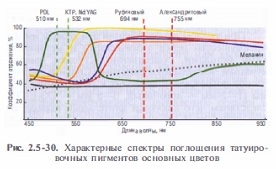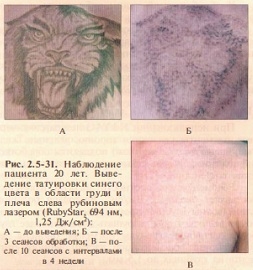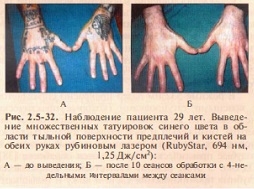The word tattoo (tatoo, tattoo, tattoo or tatu) comes from Tahitian tatau and Marquesan ta-tu – wound, sign 9 or from ta – picture and atu – spirit). The need to destroy particles of a pigment introduced from outside arises when the patient wants to remove a tattoo that has become irrelevant, when the skin is impregnated as a result of trauma, and when correcting permanent makeup (or its side effects).
 Vladimir Alexandrovich Tsepkolenko
Vladimir Alexandrovich Tsepkolenko
MD, Professor, Honored Doctor of Ukraine,
President of the Ukrainian Society of Aesthetic
Medicine, General Director of the Ukrainian
Institute of Plastic Surgery
and aesthetic medicine "Virtus"
Tattoo Removal Methods
Until now, the main method of tattoo removal was the destruction or removal of the epidermis layer by mechanical, chemical or thermal means, accompanied by inflammatory processes. In this case, transepidermal removal of the pigment occurs at the stage of exudation. The inflammatory response can also promote macrophage activity and increased phagocytosis, which facilitates the removal of pigment during the healing phase.
The advent of nanosecond lasers has made it possible to remove tattoos by remotely thermally destroying pigment particles without causing serious damage to the skin itself. This process is not only much less painful, but also minimizes the risk of side effects and scarring.
Laser tattoo removal
Lasers with a pulse duration of the order of tens of nanoseconds allow tattoo removal using the selective photothermolysis technique with a minimal risk of subsequent scarring. Millisecond lasers give less predictable results with significantly greater thermal damage to the skin due to a significant excess of the thermal relaxation period of the pigment granules. Continuous laser treatment results in extensive, long-healing thermal lesions prone to significant scarring.
Dyes of different colors (sometimes of the same color, but different chemical composition) included in the pigment effectively absorb light with different wavelengths, but as a result of absorption of light by only one of them, the entire granule is often heated. The final effect may be different – from the destruction of all components of the paint to the destruction of only some of its components (not necessarily the one that absorbed the light). As a rule, organic ones can be processed better (3-7 sessions) than those based on metal oxides (20 sessions or more).
The result of processing also depends significantly on the energy density of the radiation: if it is significantly less than recommended (for a particular laser), then there is no untargeted thermal damage to tissues, and the pigment is removed inefficiently. In the opposite case, the effectiveness is high, but non-targeted thermal damage is also high: the appearance of subepidermal blisters, scarring is possible. At an energy density of 1–3 J/cm2, all the considered lasers are inefficient. On average, in one session, the tattoo is lightened by 15-50% (depending on the type of pigment and its depth).
Increasing the power of the laser also requires an increase in the interval between sessions so that the skin has time to recover, otherwise the risk of scarring and other side effects will increase. On the other hand, a large mass of heat-disintegrated pigment takes longer to be removed by macrophages. The optimal interval is 1 to 2 months using moderate laser power.
The healing process takes up to 2 weeks. Hyperpigmentation persists 1-3, less often – 12 months, depending on the patient's skin color, wavelength and laser power. Excessive energy density of radiation, especially with short-wavelength lasers, can lead to permanent pigmentation changes that require additional treatment and persist for several years. Structural changes in the skin usually disappear within 1-2 months. Due to damage to the vessels by photoacoustic waves, pinpoint hemorrhages can occur. When the effect of an explosion of tissues is manifested, it is necessary to ensure the safety of the respiratory tract of the medical staff and the patient. There is a risk of gray skin discoloration in patients receiving gold therapy.
The highest ability of pigments to absorb light (Table 7, Fig. 2.5-30):
- purple – 550 to 640 nm (green-yellow-orange-red);
- red – 505 to 560-600 nm (green);
- orange and yellow – 450 to 540 nm (blue-green);
- tan – up to 470-560 nm (blue-green);
- corporal – up to 530 nm (blue-green);
- green – 600-630 to 730-800 nm (red);
- blue-green – 400-450 to 500-560 nm (blue-violet and green);
- blue – 620 to 750-800 nm (red);
- black and gray – the entire visible range of light, optimally – 600 to 800 nm;
- melanin – maximum – up to 600 nm.
Table 7
Pigments commonly used in tattooing
| Tattoo Color | Dye used |
| Black | Charcoal, iron oxide, sandalwood |
| White | Titanium dioxide, zinc oxide |
| Flesh | Iron oxide |
| Blue | Cobalt aluminate |
| Green | Titanium dioxide, chromium oxide, malachite green, ferrocyanide |
| Yellow | Ocher, cadmium sulfide, curcumin yellow |
| Brown | Ochre |
| Red | Mercury sulfide, cadmium selenide, ochre |

The main types of lasers for tattoo removal
- Nd:YAG (1064 nm) – dark (black and blue) tattoos.
- Nd:YAG (532 nm) – red and orange tattoos.
- Dye laser (510 nm) – red, orange, yellow tattoos.
- Alexandrite laser (755 nm) – green, black and blue tattoos.
- Ruby laser (694 nm) – green, black and blue tattoos.
Nanosecond ruby laser, 694 nm
The ruby laser is highly effective at removing black, blue-black, magenta, violet and green dyes. Red pigment is difficult to process. Due to the relatively small depth of penetration of radiation into the skin, the treatment of deep-lying pigment is inefficient, most of the energy is spent on non-targeted heating; The use of long wavelength lasers to destroy residual pigment in repeated procedures can be very effective. Strong absorption by melanin makes it impossible to safely treat dark skin (Fitzpatrick types IV-VI). Recommended radiation energy density – about 6 J/cm2, Large – leads to a significant increase in side effects.
Hypopigmentation occurs in more than 50% of patients and usually lasts up to 6 months, temporary hyperpigmentation is common. The likelihood of scarring and structural changes – to 10%. Epidermal cooling significantly reduces the likelihood and intensity of all side effects (Fig. 2.5-31, 2.5-32).


Nanosecond Alexandrite Laser, 755 nm
Light with a wavelength of 755 nm is well absorbed by black, blue and green pigments; orange pigment absorbs it much weaker, and red – quite weak. The penetration depth of the radiation of this laser is somewhat greater than that of the ruby laser, which improves the results of removing deeply located pigment granules. Less light absorption by melanin facilitates Fitzpatrick Type III skin treatment (Type IV-VI treatment is not recommended). Absorption by hemoglobin is also significantly weaker compared to the ruby laser. The recommended radiation energy density is 6-8 J/cm2.
Scarring and atrophy are not observed in the treated tissue. In 50% of patients, after four or more sessions, temporary hypopigmentation may occur, which disappears within a few months. In 10% of cases, temporary structural changes in the skin surface are observed, which resolve in 3-9 months.
Nanosecond Nd:YAG laser, 1064 (532) nm
When using Nd:YAG laser, blue-red pigments are removed well; greens, yellows, whites and reds are difficult to process, while purples and oranges are almost unaffected.
The recommended radiation energy density is about 12 J/cm2. Due to the long wavelength, the penetration depth of the light is large enough to destroy even the deepest pigment granules: a biopsy shows fragmentation of black pigment particles at depths of up to 1.5 mm.
Weak absorption of radiation by melanin makes it possible to successfully treat even dark skin, it is possible to remove eyelid tattoo without severe damage to the eyelashes. The probability and intensity of hypo- and hyperpigmentation is minimal, and cases of scarring are also practically not observed. Structural changes usually resolve within 1-2 months.
In the 532 nm mode, the laser does an excellent job with red tattoos (which are practically not amenable to ruby and alexandrite lasers); orange and violet pigments can also be laser processed, while yellow, green and blue pigments are almost impossible to process. However, this mode significantly reduces the depth of penetration of light into the skin and increases the likelihood of side effects (especially when treating dark skin).
Dye lasers, 510, 575-600 nm
Pulsed dye lasers are effective enough to destroy red, orange and yellow tattoo pigment, but their absorption by melanin and hemoglobin is quite high. The small depth of penetration of radiation into the skin allows processing only a shallow pigment. Strong absorption by melanin significantly complicates the treatment of even Fitzpatrick phototype III skin, the likelihood of pigmentation changes is much higher than after ruby laser treatment.
Argon laser, 488, 514 nm; CO2 laser, 10600 nm
When skillfully used, these lasers have an advantage over chemical and mechanical methods, and are significantly inferior to nanosecond pulsed lasers. Strong thermal damage leads to the destruction of the dermis 91-2 mm – argon, 3-5 mm – CO2), resulting in a long healing period (up to 2 months) and a high likelihood of extensive hypertrophic scarring. A significant part of the pigment often remains.
Side effects of laser treatment
Hypopigmentation is associated with the absorption of short light waves by melanin, is usually temporary and disappears completely within 4-12 months.
Black patients are more prone to hyperpigmentation regardless of the type of laser used. A sunscreen with a high SPF and whitening products can help fade hyperpigmentation within a few months, but sometimes the process can take longer.
Structural changes and scarring are rare. Temporary structural changes appear quite often, but disappear within 1-2 months. Increasing the intervals between procedures up to 2-3 months significantly reduces the risk of permanent structural changes. Scarring is possible when combustible substances that have entered the skin during an injury are treated with a laser.
An allergic reaction to the breakdown products of tattoo pigments is possible, and in such cases, further laser tattoo removal is not recommended. In the future, it is possible to create an international registry of potentially dangerous dyes, tattoos with which will not be treated with a laser.
Permanent make-up correction
The main difference between permanent makeup and a regular tattoo is the relatively shallow depth of application of the pigment – its main mass is contained in the lower layers of the epidermis, and in the process of desquamation of the latter, a gradual independent elimination of pigmentation occurs. The need for correction often leads to incorrect application of the pigment, its uneven loss.
Traditional ways to remove permanent makeup - surgical excision, pigment scraping and tannic acid injections – can lead to inversion or eversion of the eyelid, deformation of the red border of the lips, scarring. When the pigment is vaporized with an argon laser, significant thermal damage occurs, leading to eyelash loss and other complications. Er:YAG laser ablation of the upper skin layer of thin thickness is recommended, along with most of the pigment and minimal side effects.
Nanosecond lasers are preferred for facial tattoo removal (eyebrow tattoo, tarsal pigment scattering), but it is difficult to avoid temporary or permanent loss of pigmented hair due to thermal damage. High radiation energy density and too short pulses increase the risk of tissue damage.
Research has shown that many pigments containing titanium dioxide or iron oxide change color when exposed to nanosecond lasers due to the fact that iron oxide changes color from brown to black at temperatures above 1400°C.
Thus, when correcting a colored tattoo, a test treatment of small areas is recommended to assess possible side effects.









Add a comment